Adaptive Cruise Control (ACC) with Low Speed Follow
Helps maintain a constant vehicle speed and a set following-interval behind a vehicle detected ahead of yours and, if the detected vehicle comes to a stop, can decelerate and stop your vehicle, without you having to keep your foot on the brake or the accelerator.
When ACC with Low Speed Follow slows your vehicle by applying the brakes, your vehicle’s brake lights will illuminate.

- WARNING
-
Improper use of ACC with Low Speed Follow can lead to a crash.
Use ACC with Low Speed Follow only when driving on expressways or freeways and in good road and weather conditions.
- WARNING
-
ACC with Low Speed Follow has limited braking capability and may not stop your vehicle in time to avoid a collision with a vehicle that quickly stops in front of you.
Always be prepared to apply the brake pedal if the conditions require.
- WARNING
-
Exiting a vehicle that has been stopped while the ACC with Low Speed Follow system is operating can result in the vehicle moving without operator control.
A vehicle that moves without operator control can cause a crash, resulting in serious injury or death.
Never exit a vehicle when the vehicle is stopped by ACC with Low Speed Follow.
- Detail
-
Important ReminderAs with any system, there are limits to ACC with Low Speed Follow. Use the brake pedal whenever necessary, and always keep a safe interval between your vehicle and other vehicles.While in ECON mode, or when you have selected ECON for ACC in the INDIVIDUAL Settings screen, it may take relatively more time to accelerate to maintain the set speed.For directions on the proper handling of the radar sensor, refer to the following page.
You can read about handling information for the camera equipped with this system.
The radar sensor for ACC with Low Speed Follow is shared with the collision mitigation braking systemTM (CMBSTM).
ACC with Low Speed Follow may not work properly under certain conditions.
When not using ACC with Low Speed Follow: Turn off adaptive cruise by pressing the button.Do not use ACC with Low Speed Follow under the following conditions:
button.Do not use ACC with Low Speed Follow under the following conditions:- On roads with frequent lane change or continuous stop and go traffic, ACC with Low Speed Follow cannot keep an appropriate distance between your vehicle and the vehicle ahead of you.
- On roads with sharp turns.
- On roads with toll collection facilities or other objects between lanes of traffic, or in parking areas, or facilities with drive through access.
- On roads with bad weather (rain, fog, snow, etc.), ACC with Low Speed Follow may not detect the distance between your vehicle and the vehicle ahead of you properly.
- On roads with slippery or icy surfaces. The wheels may spin out and your vehicle may lose the control on the condition.
- On roads with steep uphill or steep downhill slopes.
- On roads with undulating slopes.
How to activate the system
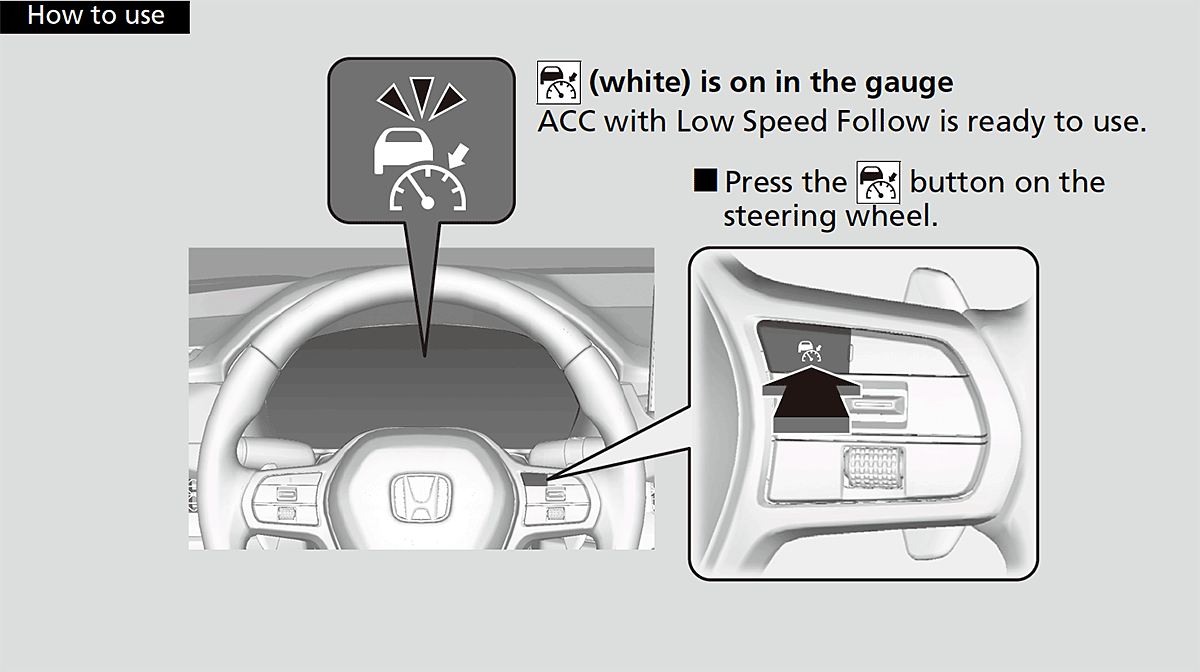
To Set the Vehicle Speed
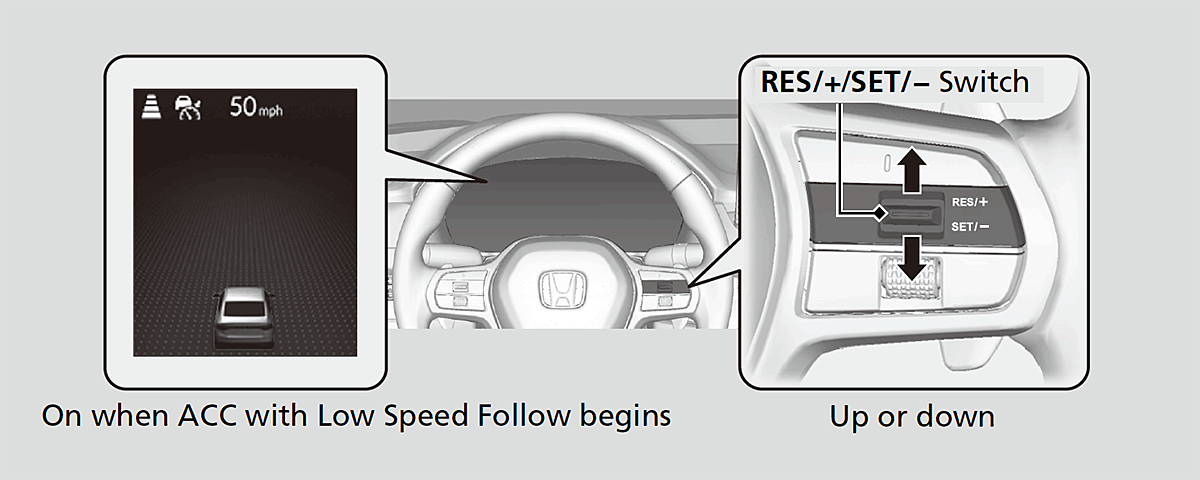
When driving at about 25 mph (40 km/h) or above: Take your foot off the pedal and press the RES/+/SET/− switch up or down when you reach the desired speed. The moment you release the switch, the set speed is fixed, and ACC with Low Speed Follow begins.
When you use ACC with Low Speed Follow, Straight Driving Assist (a feature of the Electric Power Steering system) is activated.
By enabling the steering system to automatically compensate for natural steering pull, Straight Driving Assist makes it easier for you to keep your vehicle in a straight line.
When driving slower than about 25 mph (40 km/h): If the vehicle is moving and the brake pedal is not depressed, pressing the switch fixes the set speed to about 25 mph (40 km/h) regardless of current vehicle speed. If your vehicle is stationary, you can set the vehicle speed even with the brake pedal depressed.
-
When ACC with Low Speed Follow starts operating, the vehicle icon, interval bars and set speed appear on the gauge.
-
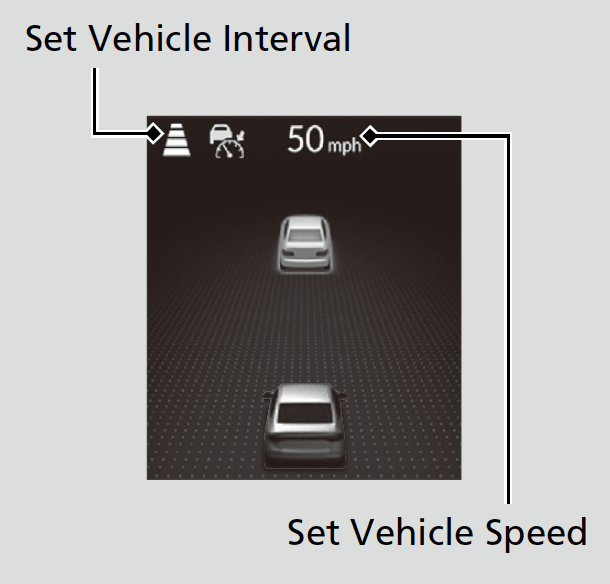
- Detail
-
The Vehicle Stability AssistTM (VSA®) system, Adaptive Cruise Control (ACC) with Low Speed Follow, safety support, low tire pressure/TPMS*, and parking brake and brake system (amber) indicators may come on in amber along with a message in the gauge when you set the power mode to ON after reconnecting the 12-volt battery.
Drive a short distance at more than 12 mph (20 km/h).
Each indicator should go off. If any do not, have your vehicle checked by a dealer.You can switch the displayed set speed measurements on the driver information interface or audio/information screen between mph and km/h.
When in Operation
- Detail
-
If the vehicle ahead of you slows down abruptly, or if another vehicle cuts in front of you, a beeper sounds and a message appears on the driver information interface.
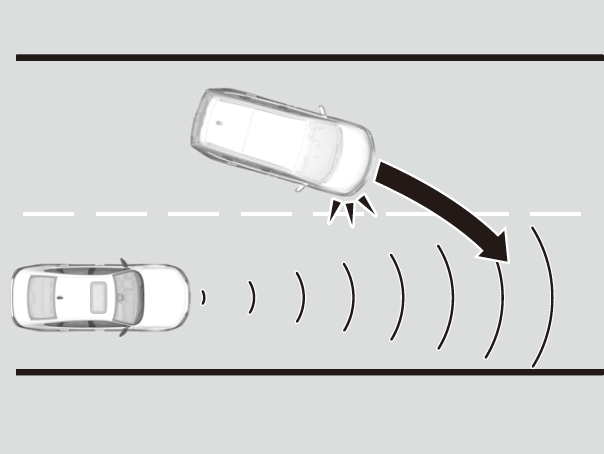 Depress the brake pedal, and keep an appropriate interval from the vehicle ahead.
Depress the brake pedal, and keep an appropriate interval from the vehicle ahead. Even if the interval between your vehicle and the vehicle detected ahead is short, ACC with Low Speed Follow may start accelerating your vehicle under the following circumstances:
Even if the interval between your vehicle and the vehicle detected ahead is short, ACC with Low Speed Follow may start accelerating your vehicle under the following circumstances:- The vehicle ahead of you is going at almost the same speed as, or faster than, your vehicle.
- A vehicle that cuts in front of you is going faster than your vehicle, gradually increasing the interval between the vehicles.
You can also set the system to beep when a vehicle in front of you comes in and goes out of the ACC with Low Speed Follow detecting range. A vehicle detect beep on and off can be selected.
LimitationsYou may need to use the brake to maintain a safe interval when using ACC with Low Speed Follow. Additionally, ACC with Low Speed Follow may not work properly under certain conditions.
- ACC with Low Speed Follow may temporarily control the interval between your vehicle and the vehicle in adjacent lane or surroundings of your vehicle depending on the road conditions (e.g., curves) or vehicle conditions (e.g., operating the steering wheel or the vehicle location in the lane).
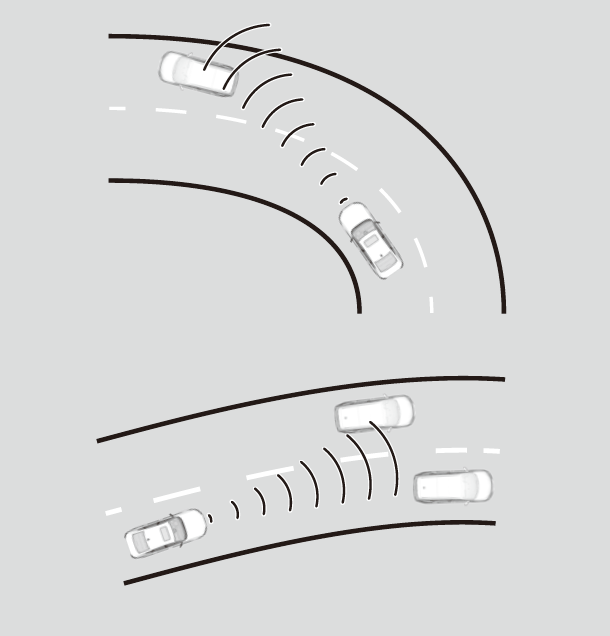
- When the vehicle ahead of you moves away, such as when entering an interchange or rest area, ACC with Low Speed Follow may continue to maintain the set following-interval for a short time.
There is a vehicle ahead
ACC with Low Speed Follow monitors if a vehicle ahead of you enters the ACC with Low Speed Follow range. If a vehicle is detected doing so, the ACC with Low Speed Follow system maintains or decelerates your vehicle’s set speed in order to keep the vehicle’s set following-interval from the vehicle ahead.
To Set or Change Following-interval

-
When a vehicle whose speed is slower than your set speed comes in or cuts in front of you and is detected by the radar and the camera, your vehicle starts to slow down.
-
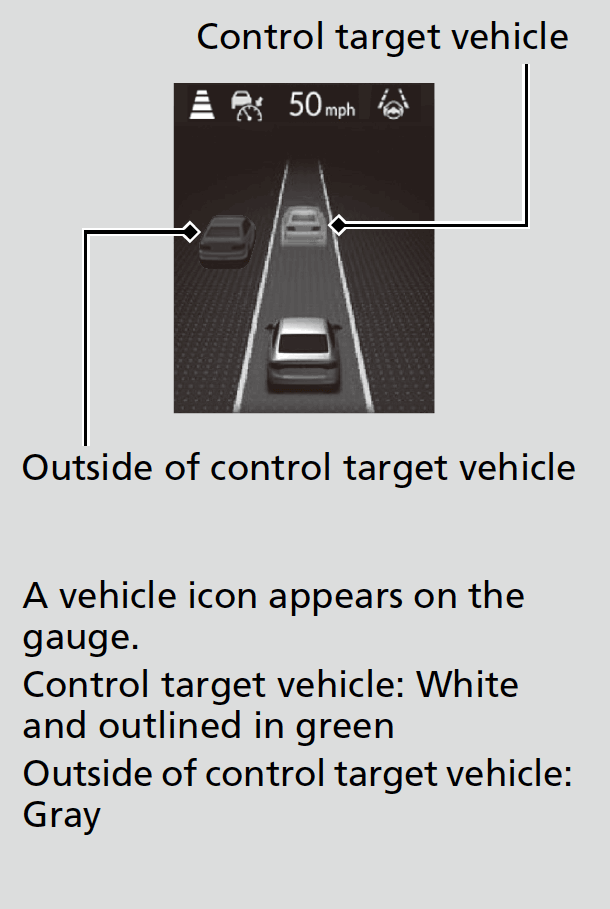
There is no vehicle ahead
-
Your vehicle maintains the set speed without having to keep your foot on the brake or accelerator pedal.
If there previously was a vehicle detected ahead that kept your vehicle from traveling at the set speed, ACC with Low Speed Follow accelerates your vehicle to the set speed, and then maintains it.While driving down steep hills, ACC with Low Speed Follow brakes to inhibit excessive acceleration for maintaining the set speed. However, the vehicle speed may become faster than the set speed.
-
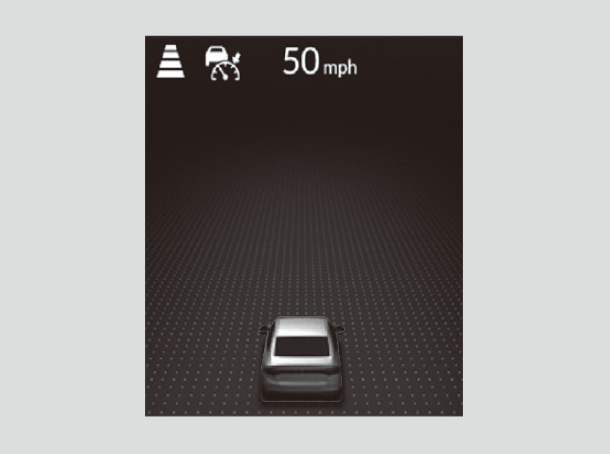
When you depress the accelerator pedal
You can temporarily increase the vehicle speed. In this case, there is no audible or visual alert even if a vehicle is in the ACC with Low Speed Follow range.
ACC with Low Speed Follow stays on unless you cancel it. Once you release the accelerator pedal, the system resumes an appropriate speed for keeping the following-interval while a vehicle ahead is within the ACC with Low Speed Follow range.
A vehicle detected ahead is within ACC with Low Speed Follow range and slows to a stop
-
Your vehicle also stops, automatically. The Stopped message appears on the gauge.
When the vehicle ahead of you starts again, if you press the RES/+/SET/− switch up or down, or depress the accelerator pedal, ACC with Low Speed Follow will operate again within the prior set speed. -
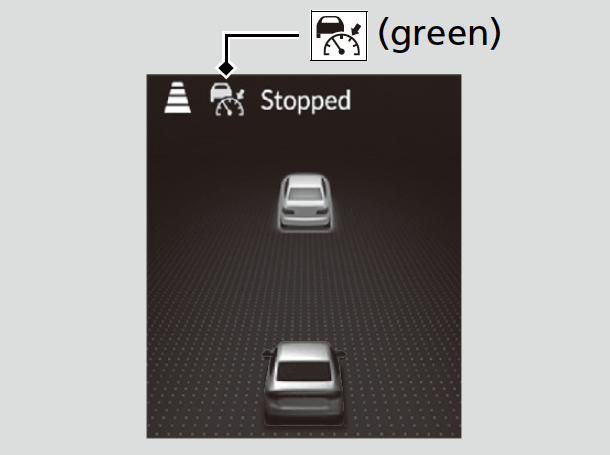
-
If no vehicle is ahead of you before you resume driving, depress the accelerator pedal and ACC with Low Speed Follow will operate again within the prior set speed.
-
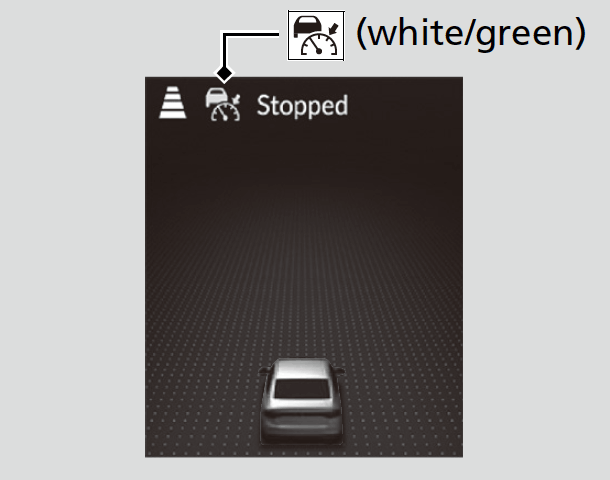
ACC with Low Speed Follow Conditions and Limitations
The system may automatically shut off under certain conditions. Some examples of these conditions are listed below. Other conditions may reduce some of the ACC with Low Speed Follow functions.
- Detail
-
Always keep the radar sensor cover clean.Never use chemical solvents or polishing powder for cleaning the sensor cover. Clean it with water or a mild detergent.Do not put a sticker on the radar sensor cover or replace the radar sensor cover.If you need the radar sensor to be repaired, or removed, or the radar sensor cover is strongly impacted, turn off the system by pressing the
 button and take your vehicle to a dealer.Have your vehicle checked by a dealer if you find any unusual behavior of the system (e.g., the warning message appears too frequently).If the front of the vehicle is impacted in any of the following situations, the radar sensor may not work properly. Have your vehicle checked by a dealer:
button and take your vehicle to a dealer.Have your vehicle checked by a dealer if you find any unusual behavior of the system (e.g., the warning message appears too frequently).If the front of the vehicle is impacted in any of the following situations, the radar sensor may not work properly. Have your vehicle checked by a dealer:- The vehicle mounted onto a bump, curb, chock, embankment, etc.
- You drive the vehicle where water is deep.
- Your vehicle has a frontal collision.
Environmental conditions
- Driving in bad weather (rain, fog, snow, etc.).
Roadway conditions
- Driving on a snowy or wet roadway (obscured lane marking, vehicle tracks, reflected lights, road spray, high contrast).
Vehicle conditions
- The outside of the windshield is blocked by dirt, mud, leaves, wet snow, etc.
- An abnormal tire or wheel condition (incorrect sizes, varied sizes or construction, improperly inflated, etc.).
- The camera temperature gets too high.
- The electric parking brake is applied.
- When the front grille is dirty.
- The vehicle is tilted due to a heavy load or suspension modifications.
- When tire chains* are installed.
Detection limitations
- A vehicle suddenly crosses in front of you.
- The interval between your vehicle and the vehicle ahead of you is too short.
- A vehicle cuts in front of you at a slow speed, and it brakes suddenly.
- You accelerate rapidly and approach the vehicle ahead of you at high speed.
- The vehicle ahead of you is a motorcycle, bicycle, mobility scooter, or other small vehicle.
- There are animals in front of your vehicle.
- You drive on a curved or winding or undulating road that makes it difficult for the sensor to properly detect a vehicle in front of you.

- A vehicle ahead of you stops and the speed difference between your vehicle and the vehicle ahead of you is significantly large.
- An oncoming vehicle suddenly comes in front of you.
- Your vehicle abruptly crosses over in front of an oncoming vehicle.
- Driving through a narrow metal bridge.
- The vehicle ahead of you brakes suddenly.
- The vehicle ahead of you has a unique shape.
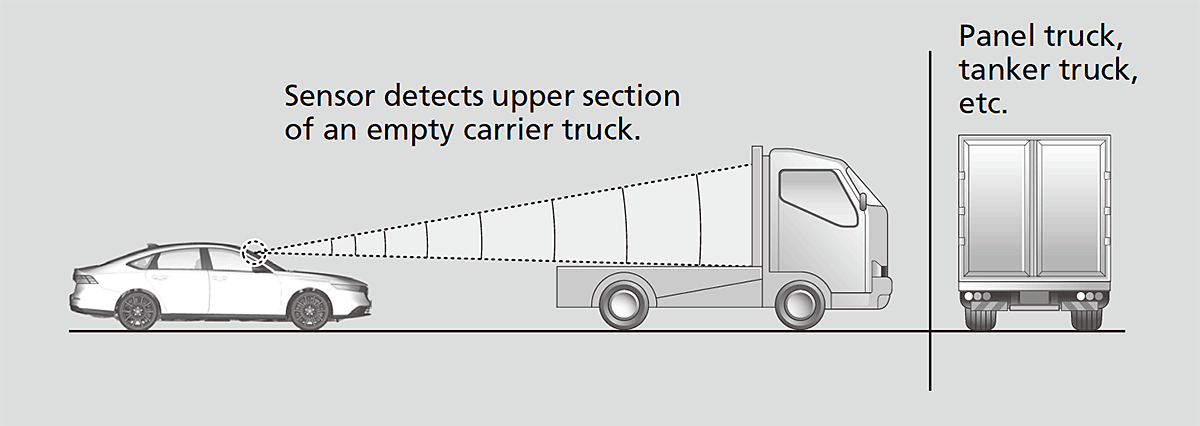
- Your vehicle or the vehicle ahead of you is driving on one edge of the lane.
- When the minimum ground clearance of a vehicle ahead of you is extremely high.

To Adjust the Vehicle Speed
Increase or decrease the vehicle speed using the RES/+/SET/−switch on the steering wheel.
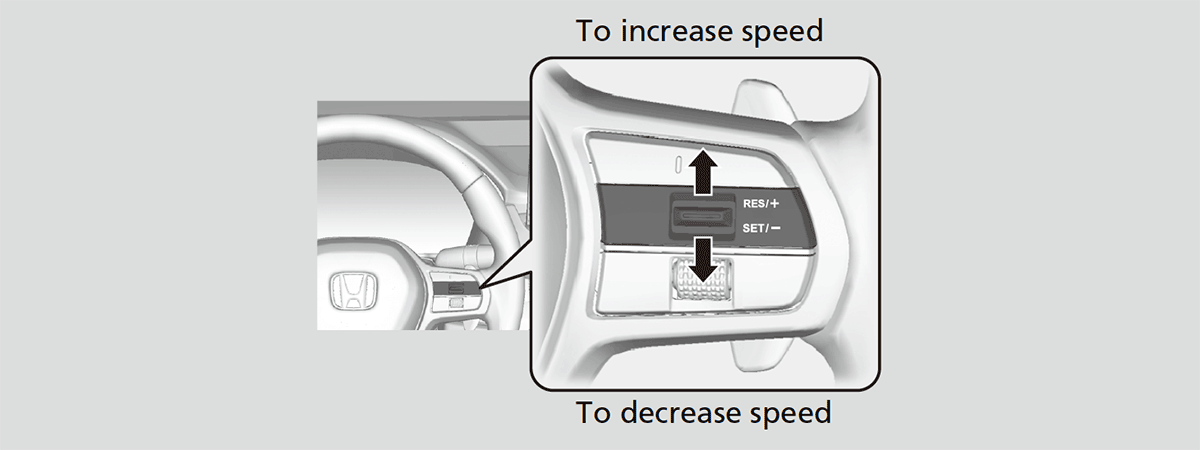
- Each time you press the RES/+/SET/−switch up or down, the vehicle speed is increased or decreased by about 1 mph or 1 km/h accordingly.
- If you keep the RES/+/SET/−switch pressed up or down, the vehicle speed increases or decreases by about 5 mph or 5 km/h accordingly.
- Detail
-
If a vehicle detected ahead is going at a speed slower than your increased set speed, ACC with Low Speed Follow may not accelerate your vehicle. This is to maintain the set interval between your vehicle and the vehicle ahead.When you depress the accelerator pedal and then press down and release the RES/+/SET/−switch, the current speed of the vehicle is set.
To Set or Change Following-interval
-
Press the Interval button to change the ACC with Low Speed Follow following-interval.
Each time you press the button, the following-interval (the interval behind a vehicle detected ahead of you) setting cycles through furthest, far, mid, and nearest following-intervals.Determine the most appropriate following-interval setting based on your specific driving conditions. Be sure to adhere to any following-interval requirements set by local regulation.
-
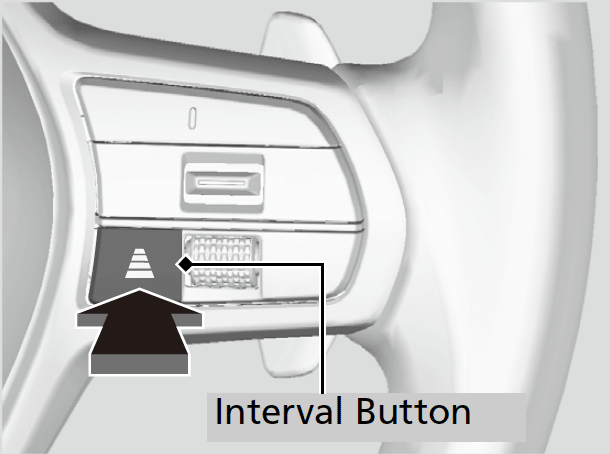
The higher your vehicle’s following-speed is, the longer the nearest, mid, far or furthest following-interval becomes. See the following examples for your reference.
|
Following-interval
|
When the Set Speed is:
|
||
|---|---|---|---|
|
50 mph (80 km/h)
|
65 mph (104 km/h)
|
||
|
Nearest
|
 |
82 feet
25 meters 1.1 sec
|
102 feet
31 meters 1.1 sec
|
|
Mid
|
 |
108 feet
33 meters 1.5 sec
|
138 feet
42 meters 1.5 sec
|
|
Far
|
 |
154 feet
47 meters 2.1 sec
|
200 feet
61 meters 2.1 sec
|
|
Furthest
|
 |
213 feet
65 meters 2.9 sec
|
282 feet
86 meters 2.9 sec
|
When your vehicle stops automatically because a vehicle detected ahead of you has stopped, the interval between the two vehicles will vary based on the ACC with Low Speed Follow interval setting.
To Cancel
-
To cancel ACC with Low Speed Follow, do any of the following:
- Press the CANCEL button.
- The
 indicator (green) on the gauge changes to the
indicator (green) on the gauge changes to the  indicator (white).
indicator (white).
- The
- Press the
 button.
button. indicator (green) goes off.
indicator (green) goes off.
- Depress the brake pedal while the vehicle is moving forward.
- The
 indicator (green) on the gauge changes to the
indicator (green) on the gauge changes to the  indicator (white).
indicator (white).
- The
- Press the CANCEL button.
-
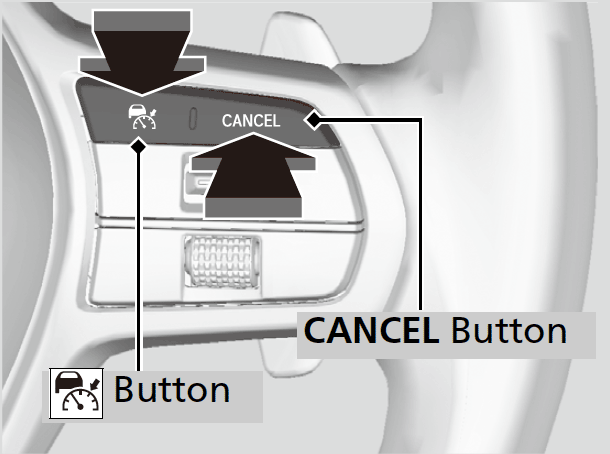
- Detail
-
Resuming the prior set speed: After you have canceled ACC with Low Speed Follow, you can activate the ACC with Low Speed Follow with the prior set speed displayed on the gauge (in gray) by pressing the RES/+/SET/− switch up even if the vehicle is stopped.
When you turn the ACC with Low Speed Follow off by pressing the CANCEL button or depressing the brake pedal, the prior set speed is displayed on the gauge in gray.
When pressing the RES/+/SET/− switch up, the ACC with Low Speed Follow is activated with displayed speed.
If the indicator (white) is displayed and you press the RES/+/SET/− switch up, but no prior set speed (in gray) is displayed, the speed will be set to your vehicle's current speed.
indicator (white) is displayed and you press the RES/+/SET/− switch up, but no prior set speed (in gray) is displayed, the speed will be set to your vehicle's current speed.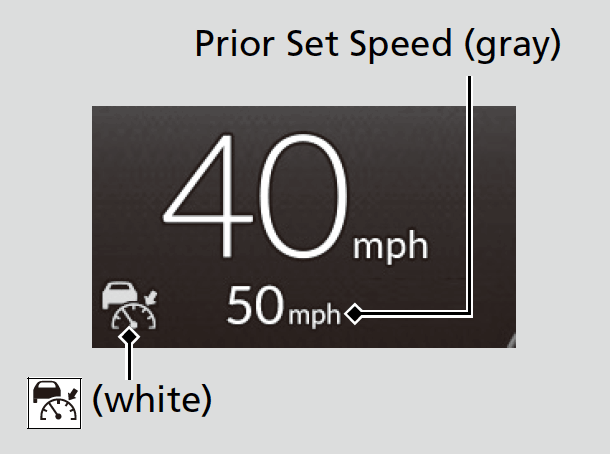 The set speed cannot be set or resumed when ACC with Low Speed Follow has been turned off using the
The set speed cannot be set or resumed when ACC with Low Speed Follow has been turned off using the button. Press the
button. Press the  button to activate the system, then set the desired speed.
button to activate the system, then set the desired speed.
Automatic cancellation
The beeper sounds and a message appears on the driver information interface when ACC with Low Speed Follow is automatically canceled. Any of these conditions may cause the ACC with Low Speed Follow to automatically cancel:
- Bad weather (rain, fog, snow, etc.)
- When the radar sensor behind the Honda emblem gets dirty.
- The vehicle ahead of you cannot be detected.
- An abnormal tire condition is detected, or the tires are skidding.
- Driving on a mountainous road for extended periods, or driving off road.
- Abrupt steering wheel movement.
- When the ABS, VSA®, CMBSTM, or Low Speed Braking Control* is activated.
- When the ABS or VSA® system indicator comes on.
- When the vehicle is stopped on a very steep slope.
- When you manually apply the parking brake.
- When the detected vehicle within the ACC with Low Speed Follow range is too close to your vehicle.
- When accelerating rapidly.
- The camera behind the rearview mirror, or the area around the camera, including the windshield, gets dirty.
- The vehicle has repeatedly applied the brakes to maintain the set speed (for example, you are descending a long slope).
- When the system doesn't detect any driving actions from the driver for a certain amount of time while the LKAS is also activated.
- When the Maximum Load Limit is exceeded.
- When passing through an enclosed space, such as tunnel.
- When the parking brake and brake system indicator (amber) comes on.
The ACC with Low Speed Follow automatic cancellation can be also triggered by the following causes. In these cases, the parking brake will be automatically applied.
- The driver’s seat belt is unfastened when the vehicle is stationary.
- The vehicle stops for more than 10 minutes.
- The power system is turned off.
To Switch ACC with Low Speed Follow to Cruise Control
-
Press and hold the Interval button for one second. Cruise mode selected appears on the driver information interface for two seconds, and then the mode switches to Cruise.
The indicator comes on.
indicator comes on.- Green: The system is on.
- White: The system is standby.
To switch back to ACC with Low Speed Follow, press and hold the Interval button again for one second.
-
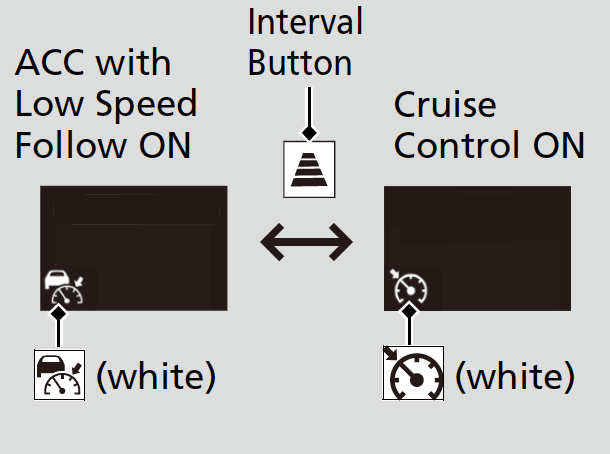
- Detail
-
Always be aware which mode you are in. When you are driving in Cruise mode, the system will not assist you to maintain a following-interval from a vehicle ahead of you.You cannot switch ACC with Low Speed Follow to Cruise Control in the following situations:
- When the vehicle speed is set.
- When ACC with Low Speed Follow is not activated.
You can switch the displayed set speed measurements on the driver information interface or audio/information screen between mph and km/h.
When to use
Desired speed in a range above roughly 25 mph (40 km/h).
To Set the Vehicle Speed
Take your foot off the pedal and press the RES/+/SET/− switch up or down when you reach the desired speed.
The moment you release the RES/+/SET/− switch, the set speed is fixed, and cruise control begins. The color of  indicator changes from white to green and set speed appears on the gauge.
indicator changes from white to green and set speed appears on the gauge.
When you use cruise control, Straight Driving Assist (a feature of the Electric Power Steering system) is activated.
By enabling the steering system to automatically compensate for natural steering pull, Straight Driving Assist makes it easier for you to keep your vehicle in a straight line.
To Adjust the Vehicle Speed
- Each time you press the RES/+/SET/− switch up or down, the vehicle speed is increased or decreased by about 1 mph or 1 km/h accordingly.
- If you keep the RES/+/SET/− switch pressed up or down, the vehicle speed increases or decreases by about 5 mph or 5 km/h accordingly.
To Cancel
To cancel cruise control, do any of the following:
- Press the CANCEL button.
- The
 indicator (green) on the gauge changes to the
indicator (green) on the gauge changes to the  indicator (white).
indicator (white).
- The
- Press the
 button.
button.- The
 indicator (green) goes off.
indicator (green) goes off.
- The
- Depress the brake pedal.
- The
 indicator (green) on the gauge changes to the
indicator (green) on the gauge changes to the  indicator (white).
indicator (white).
- The
- Detail
-
Resuming the prior set speed: After you have canceled cruise control, you can activate the cruise control with the prior set speed displayed on the gauge (in gray) by pressing the RES/+/SET/− switch up while driving at a speed of at least 25 mph (40 km/h) or more.
When you turn the cruise control off by pressing the CANCEL button or depressing the brake pedal, the prior set speed is displayed on the gauge in gray.
When pressing the RES/+/SET/− switch up, the cruise control is activated with displayed speed.
If the indicator (white) is displayed and you press the RES/+/SET/− switch up, but no prior set speed (in gray) is displayed, the speed will be set to your vehicle's current speed.
indicator (white) is displayed and you press the RES/+/SET/− switch up, but no prior set speed (in gray) is displayed, the speed will be set to your vehicle's current speed.
You cannot set or resume in the following situations: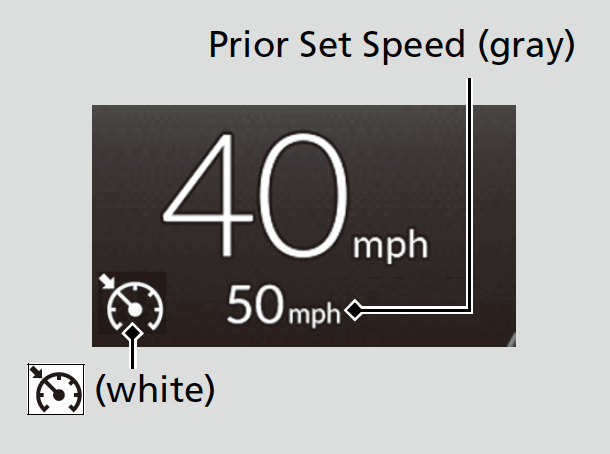
- When vehicle speed is less than 25 mph (40 km/h)
- When cruise control is canceled by pressing the
 button.
button.
At vehicle speeds of 22 mph (35 km/h) or less, cruise control is canceled automatically.
* Not available on all models
- Recommended topic(s)


